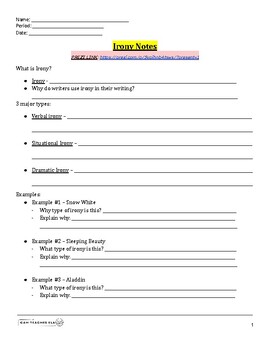Irony Prezi & Notes + Identifying Irony Activity using The Twilight Zone
Cam Teaches ELA
2 Followers
Grade Levels
6th - 10th
Resource Type
Standards
CCSSRL.6.7
CCSSRL.6.10
CCSSRL.7.3
CCSSRL.7.10
CCSSRL.8.6
Formats Included
- PDF
- Prezis
Pages
6 pages
Cam Teaches ELA
2 Followers
Description
This is an introduction lesson to teaching the three different types of irony to students. This activity is great for middle grades 6-8 or ELA 9-10.
- Part 1 (15-25 minutes): Students will start with taking brief notes on irony following by examples. (Page 1 in the packet)
- Part 2 (30-45 minutes): Students will watch the Twilight Zone episode S5, E3 titled "Nightmare at 20,000 Feet," which is 25 minutes long. This episode streams for free on Amazon Prime and Paramount+). As they watch, they will identify which types of irony they see from the examples in the film provided on the worksheet. They will also explain why that example reflects the type of irony shown in the example. (Pages 2-6 in the packet)
Learning Objectives:
- Students will be able to define the three different types of irony.
- Students will be able to identify examples of each type of irony in a work of fiction.
- Students will be able to explain how a specific type of irony is demonstrated in a work of fiction.
Thank you for choosing Cam Teaches ELA!
Cameron Vandenboom
chvandenboom@gmail.com
Total Pages
6 pages
Answer Key
N/A
Teaching Duration
55 minutes
Report this resource to TPT
Reported resources will be reviewed by our team. Report this resource to let us know if this resource violates TPT’s content guidelines.
Standards
to see state-specific standards (only available in the US).
CCSSRL.6.7
Compare and contrast the experience of reading a story, drama, or poem to listening to or viewing an audio, video, or live version of the text, including contrasting what they “see” and “hear” when reading the text to what they perceive when they listen or watch.
CCSSRL.6.10
By the end of the year, read and comprehend literature, including stories, dramas, and poems, in the grades 6–8 text complexity band proficiently, with scaffolding as needed at the high end of the range.
CCSSRL.7.3
Analyze how particular elements of a story or drama interact (e.g., how setting shapes the characters or plot).
CCSSRL.7.10
By the end of the year, read and comprehend literature, including stories, dramas, and poems, in the grades 6–8 text complexity band proficiently, with scaffolding as needed at the high end of the range.
CCSSRL.8.6
Analyze how differences in the points of view of the characters and the audience or reader (e.g., created through the use of dramatic irony) create such effects as suspense or humor.





